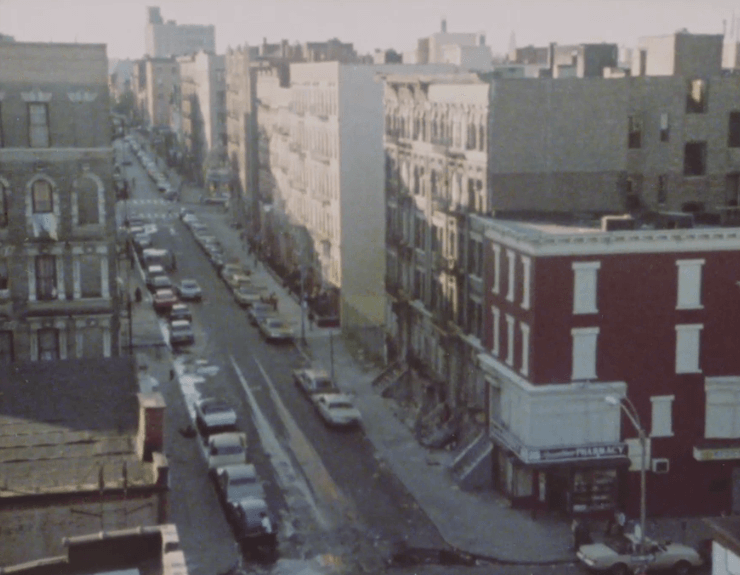“Neighborhoods Shift, but They Do Not Disappear”: Talking about Los Sures, a Brooklyn Barrio
Gentrification anxiety may be all over Williamsburg (and beyond), but it’s nowhere to be found in Diego Echevarria’s 1983 documentary Los Sures. Back then, this particular pocket of Brooklyn—bracketed between the East River and Union Avenue, sandwiched above the Hasidic neighborhood and below Metropolitan—was the dominion of some of New York’s very poorest, the majority of them Puerto Rican. Many of Echevarria’s interviewees talk about leaving the neighborhood with breathless anticipation, but the Latino community remains, and its signifiers are unmistakable to anyone who knows the area beyond Bedford Ave & McCarren Park: guys blasting salsa music down the block, games of dominos played out on the sidewalk, or parties being held in some makeshift underground clubhouse.
Speaking about Los Sures—originally produced for public broadcasting via WNET, as part of producer David Loxton’s groundbreaking TV Lab—Echeverria can’t help but wax philosophical: “We were a generation of documentarians that were basically dealing, from the 1960s until the end of the ‘80s, with issues of poverty, discrimination, civil rights. We were looking at that with an enormous amount of passion, like, ‘What can we do?’”
I was surprised to hear that Echeverria’s approach to filming the documentary, which follows five “characters” from the community, was not just meticulous, but by shoestring filmmaking standards, generous: “We shot for 35 or 40 days. Basically, we were choosing situations that we really felt, you know, were very representative of the story we were hearing, that we wanted to document.”
“You don’t want a story retold; you know, that it’s not fresh. Each one of the people that we chose, it was an immediate sense of saying, ‘there’s a wonderful story here.’ There was no trial and error. We were hanging out, we got to meet people, we had many conversations, but the ‘characters’ we finally chose were people that we really felt very strongly were gonna give us a sense of the neighborhood, with contrasting stories to tell.
Los Sures has had a curious second life, thanks largely to Christopher Allen and UnionDocs, the microcinema/documentary workshop he cofounded on the avenue of same name. Allen initially angled merely to screen it to the public, but has since campaigned, successfully, to finance a 3K restoration, which was completed in time for last year’s New York Film Festival, and which Echeverria prefers to his worn-out 16mm print.
UnionDocs has two concomitant programs expanding its survey of the neighborhood: the multivalent “Living Los Sures” project (formerly titled “Looking At Los Sures”) requires UnionDocs’ annual class of documentary fellows to create short-form works within—and about—the neighborhood.
Both Allen and Echeverria offer that the south side has changed less than you might think, but there are juxtapositions to be drawn from UnionDocs’ “Shot By Shot” deconstruction of Los Sures that are legitimately mindblowing. Echeverria’s footage is picked apart one image at a time, burrowing into between-peripheral details, opens up sprawling miniature narratives threaded therein. Reminiscences and observations from longtime residents (some of whom appear in the footage) are collected, allowing viewers to check in on them three decades later; it’s enough to make fans of the Up series salivate.
“This project is a constellation of windows to look through,” Allen told me. “Diego’s access to the film’s subjects is incredible, and it’s not the kind of early-television documentary you’d expect. But we heard criticism of the film too, because it didn’t tell the story of the entrepreneurs, lawyers; it’s really focused on the poverty. I think there’s a strong interest in the history of place, but representation of one place should never be singular.” For his part, Echeverria offered: “Neighborhoods shift, but they do not disappear. The problem has not disappeared, but it has shifted. In what ways is it different today than it might have been 30 years ago? The realities are still there. In most cities you find communities like Los Sures; I don’t think there’s a huge difference.”
For its illusory glimpse at the old, bad New York—although Allen stresses that things have changed less than you might think—is Los Sures more pertinent in 2015? “That’s a good question,” Echevarria tells me. “Strangely enough, the film is having more relevance today than it did thirty years ago. When I first screened it, it was well-received, we participated in the New York Film Festival, it had a good run in many ways. Today, I find that in looking back at Los Sures there has been a very rich process of valuing things that I felt were not valued enough as the film was released. There was a tremendous amount of poverty, and people being basically left out of basic social services. Or that were receiving very little support. So it’s a way of actually assessing a situation, for people who had to deal with very difficult conditions.”
“We knew in fact, okay, the situation could improve. But I think it’s a more significant statement as I look back to those people, to really learn, the strength of women, let’s say, in carrying that community. The role that young people were playing, basically, in dealing with a community that was surrounded by drugs, by people actually, y’know, facing the violence of gangs and so on. Even in regard to the more cultural aspect, the breakdancing, y’know, that was the beginning of breakdancing, in that period. We could see how important it was for those people. So when I look back at the film, I see the elements that make me reflect about the enormous kind of duress that people were going through, the elements viewers recognize. The strength of a character like Marta, a mother trying to hold onto her family, or someone like Tito, who’s unemployed, trying to learn a living by doing things that are absolutely illegal, but was able in the end to turn his life around.”
Once Los Sures—then in a grubby VHS rip—came to Allen’s attention, he began screening the film, by his own estimate, “every six months. Then we started bringing Diego up to do workshops with us, introducing him to the fellows who were gonna be working on the Los Sures project for the next ten months; now, he’s basically given UnionDocs the right to distribution. So we’ve raised funds alongside the New York Public Library to restore the film, and we’ll be starting with a screening at BAM on July 26th.”
I offer to Allen that UnionDocs could continue probing into its attendant neighborhood forever, but that this is also a model that could be applied just as readily to other documentary locations. “You feel the responsibility much more strongly when you’re embedded in a community,” he says. “There’s expectations from people who are part of the project, and how they’re represented. We don’t subscribe to a singular approach to documentary; our studio is really for experimenting, trying to push the form, trying to give people the opportunity to wrestle with these questions. At the same time, it’s an interesting pressure to have a real sense of long-term relationship to a place. A lot of documentaries, people parachute in, depending on their maker – they jump into a situation and jump out.”
Clearly, Echeverria wasn’t expecting this. “It has been, for me, quite remarkable – I always call it a gift, that really I received,” he told me. “UnionDocs having brought my film back to life, not only from the point of view of other people screening it, but also bringing it back into my own life as a project that has, today, a much greater presence than much of the work I’ve done in the past.”
Allen closes the loop: “For me, documentary is about exposing yourself to the unknown, being open to different people and stories, and trying to find them. Engagement—a critical form of engagement—is part and parcel with the work. It’s not like we thought this would make us better than other arts organizations, or ‘more authentic,’ it’s just better and more rewarding, and it’s helped UnionDocs get a broader base of support. And, y’know, the culture of an apartment building can deteriorate, super-rapidly, when people stop acknowledging each other and just saying hi.”
A Brooklyn Barrio: Living Los Sures will be at UnionDocs 322 Union Avenue, Williamsburg on Saturday, June 6th, 2015. 3:00 PM – LATE
For more information on A Brooklyn Barrio: Living Los Sures, visit here.
You might also like 





















